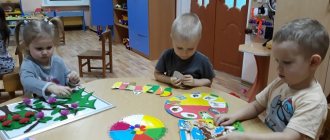What types of tasks do children like?
Preschool children prefer to solve puzzles with a set of colorful pictures, applications, and a well-thought-out motivation system (if they guess correctly, a new chip or word is revealed).
For each age, the tasks are divided according to the degree of difficulty, the presence of color, with one answer or several. Tasks can be of the same type, like a series of complementary puzzles, or contain different logical implications.
Popular options:
- searching for a soul mate;
- establishing correspondence - true or false;
- addition of geometric figures;
- simple algorithms;
- spatial thinking tasks;
- question on logic and ingenuity;
- tasks for weighing and transfusion.
These can also be chess tournaments, non-standard logical tasks and text puzzles.
How to build a lesson
In order for a child to learn to reason, make objective decisions, think flexibly and outside the box, it is necessary to create the right conditions for conducting lessons.
It is important not to overload children so that the game does not become a burden. The duration of the lesson is no more than 15-25 minutes with a break of 5 minutes. This time is enough for new knowledge to be consolidated in the child’s mind. Lessons should be taught every day in a playful way. School-age children can perform the given exercises independently.
Examples of problems with answers
Logic problems can be solved on the LogicLike online platform or purchased a printed version. Each riddle is accompanied by an answer, so you can independently check what is said with the existing solution.
Finding an extra item
An entertaining picture game for preschoolers involves choosing an extra object or word.
Problem 1
Drawn: sofa, wardrobe, lamp, table. It is necessary to determine what feature unites the objects and why one of the presented objects is redundant.
Answer: a lamp, because it is used for interior decoration, while other items are classified as furniture.
Similar options:
- wolf, fox, cat, bear;
- summer, morning, winter, spring;
- raspberries, lingonberries, viburnum, plums;
- truck, bike, car, scooter.
Problem 2: “the fourth wheel”.
There are 4 figures depicted: square, triangle, rhombus and circle. You need to choose the extra one.
Answer: circle, because other figures have angles.
Simple logic riddles
There are many options for logic problems for preschool and school age.
Popular:
- There are 5 magpies sitting in the garden bed. Three more flew towards them. The cat crept up and grabbed one magpie. How many birds are left sitting in the garden bed? (Answer: everyone flew away)
- When a heron stands on one leg, it weighs 5 kg. How much will she weigh if she stands on both legs? (Weight will not change)
- There were 5 apples on the table. One was cut into 4 parts. How many apples are left? (5)
- There were 3 glasses on the table. Vanya came up and drank from one. How many glasses are left? (3)
- A hat without a head, and a foot without a boot - what is this? (Mushroom)
- What tree does a hare hide under in the rain? (Under the wet)
- A man walked into the forest, and two acquaintances met him. How many people went into the forest? (One, the others went in the opposite direction)
- Cut the loaf into 3 parts. How many cuts were made? (2)
- If a white handkerchief is lowered into the Red Sea, what will it be like? (Wet)
- Which figure has neither beginning nor end? (Circle, oval)
- The tourist walked towards the lake, reached an intersection where four paths were indicated: right, left, to the lake and back. There were two guys sitting there, one of them always spoke the truth, and the other lied. They answered “yes” or “no” to all questions posed. It was difficult for the tourist to understand who was telling the truth. And then he said something to one of the guys, from whose answer he learned which road leads to the lake. What were those words? (Does this road lead to the lake?)
Such riddles open up an unknown world to the child, train voluntary attention, and develop intelligence. Solving problems like this is fun.
Search for a pattern
Pattern-finding tasks teach students to compare, reason, classify, draw their own conclusions, and fantasize.
Examples of problems in mathematics:
- restore the pattern - 0.10,110....11110 (1110);
- continue the number series: 23, 23, 21, 25, 19, 27 (17 and 29 - 2 less and 2 more).
There may also be tasks with a choice of presented answer options, from which you need to find the correct result.
For example, continue the series of numbers: 29, 28, 26, 23.
Possible answers:
- 20, 17, 14…
- 19, 14, 8…
- 26, 28, 29…
- 16, 10, 4…
It is important to establish compliance with the pattern.
One more task:
| 3 | 12 | 6 |
| 4 | 16 | 8 |
| 5 | 20 |
You need to enter the answer in the field. Result: 10.
Arithmetic puzzles
Numerical, arithmetic, letter, and mathematical puzzles are an entertaining game for children aged 5 years and older. Solving codes contributes to the development of attention, perseverance, and determination in a child. This is the path to gaining new knowledge.
Even simple addition and subtraction problems train logic and develop speed of thinking.
The picture shows: 3 (circle) 1 (square) 2 (circle) 3 = 5. Task: what sign is hidden in the circle? Answer: 3+1-2+3=5
When solving arithmetic puzzles, it is important to be able to draw a thread of logical conclusions and carry out arithmetic operations.
“Tasty” mathematics: a selection of popular science fairy tales for children
When asked to study mathematics during the summer holidays, a normal child will most likely respond with a sour expression. But - this is only if, instead of a boring textbook, you do not offer him entertaining books on the subject.
We play and read
In our selection you can download only three editions, but what ones! More than one generation of Russian children has grown up with them and absorbed an interest in mathematics.
Any parent interested in developing the horizons and intelligence of their child knows for sure: in childhood, the presentation of material is very important.
The success of the entire enterprise depends on how to tell it - how it will be perceived, and how it will be remembered, and how it will be learned.
Even making the bed or taking out the trash is much more interesting for a child with his agile mind and naturally developed curiosity, not under the strict parental gaze and according to clearly formulated adult rules, but in the form of a quest, a game or a fun competition.
Fascinating science for children in several books
What can we say about scientific knowledge, which is presented not in the form of dry examples and formulas, but in the form of a fairy tale with its own plot, characters, adventures and an indispensable happy ending.
And if usually a fairy tale is a lie, and there is a hint in it, then in the case of fairy tales of this kind everything is a little different.
The author's imagination awakens the child's creative and cognitive abilities and motivates him to learn new things and improve his knowledge.
The books will answer numerous “whys” and “whys”, help develop abstract and mathematical thinking in children, and most importantly, awaken scientific curiosity, from which the most incredible discoveries begin. Young Euclids and Lobachevskys, this is for you!
V. Levshin, “The Adventures of Nulik”
This book is almost a classic of Russian scientific and artistic literature.
The publication is a large trilogy, each part of which has its own name and is full of events.
Nulik is a young and inquisitive resident of the land of numbers. The hero invites the child and his parents on an exciting journey. And they will have to wander through the world of the most exact of sciences - mathematics.
The first part of the book “Three Days in Dwarfism” introduces the child to Nulik and explains how the state of numbers works.
The second part of the trilogy “The Black Mask of Al-Jebra” is designated by the author as “a journey in letters with a prologue.” The epistolary narrative tells how Nulik and his friends help a mysterious stranger break the spell of an evil wizard and at the same time learn to solve equations.
The third part of the book “Nulik the Sailor” is an “Odyssey” from the field of geometry.
Nulik and company sail on a ship across “geometric – triangular, rectangular, hexagonal, pyramidal and other – seas and oceans.”
So, children can visit a magical land - the arithmetic kingdom-state of Karlikania. The author of the tale gives them the opportunity to uncover the secret of the Black Mask from Al-Jebra.
Together with cabin boy Nulik, they will set off on a voyage across the seas and oceans of geometry.
In addition to magic and adventure - an important attribute of any fairy tale - in the book the child will learn important algebraic and geometric concepts, such as simple and decimal fractions, powers and equations, negative numbers, volumes of bodies and areas of figures.
A fascinating presentation guarantees genuine interest in the mathematical sciences.
And - a little history. The book was published in the distant Soviet years. Back in 1968, Nulik’s notes were published under the title “Captain Unit’s Frigate.” Since this frigate is not a combat ship, but a training ship, the sailors’ route was closely connected with the school mathematics curriculum.
But domestic education did not stand still. Therefore, when the program on the subject changed, the author of the book also changed a lot in the text. Then the story was republished several times. This is how the book acquired its name in honor of the main character, Nulik.
And here’s the paradox: in a good fairy tale, even zero can mean a lot!
V. Levshin. "Master of Scattered Sciences"
This bright and interesting collection includes stories by Vladimir Levshin about the adventures of his fairy-tale heroes, intended for young mathematicians, astronomers and physicists.
Do you remember in children's literature and poetry there was such a character - the Absent-Minded Man from Basseynaya Street? This time we will talk about the unlucky Master of Scattered Sciences and his companion One.
A one instead of a zero is already moving forward.
The author remains faithful to the three-part structure in this work. The collection contains several fairy-tale stories - “The Dissertation of the Absent-Minded Master”, “Travel Notes of the Absent-Minded Master”, “In Search of the Stolen Stamp”.
The Master of Absent-Minded Sciences travels around the world in pursuit of mathematical riddles and incidents. He is not only an ardent fan of mathematics, a tireless traveler, but also a great confusion. He needs help.
The poor master keeps getting into trouble and making mistakes. And his mistakes and failures are comprehended by children - schoolchildren of the Absent-Minded Master Club.
This helps them develop observation skills, improve mathematical logic and expand their knowledge base. And not only in mathematics, but also in other popular science fields.
According to teachers who tested the book on primary school children, stories full of the most incredible adventures and mistakes develop observation skills, improve mathematical logic and convincingly confirm the validity of the ancient truth: they learn from mistakes.
What doesn't happen to the heroes of this story! Exotic countries, swimming on an ice floe, walks along the edge of a volcano crater and other events await them.
In addition, together with the author's characters, little readers select mathematical keys to any lock.
Together they solve the most difficult problems. It immediately becomes clear that mathematics not only has its own immutable laws and rules, but also surprises, secrets, and paradoxes. This gives the plot a special edge.
The book is addressed to children of primary school age and their parents. Reading such a book alone will be difficult - and not as exciting as reading it with mom or dad.
Lev Gendenstein. "Alice in the Land of Mathematics"
The fairy tale about Alice is based on entertaining plots with characters from Lewis Carroll's fairy tales "Alice in Wonderland" and "Alice Through the Looking Glass".
Carroll's Alice is synonymous with everything mysterious, mysterious and extraordinary. And mathematics as a science, although it is distinguished by extreme accuracy and specificity, also contains a lot of incomprehensible things.
And the child enters this mysterious country hand in hand with Alice and the parent who dares to read this unusual text to him.
According to the author's plan, the book is designed to awaken children's genuine interest in mathematics, develop their creative imagination and logical thinking.
In addition to adventures, this publication contains a lot of useful information - historical and biographical information and excursions, thanks to which you can get acquainted with the great mathematicians of antiquity.
The little reader will discover interesting facts related to the history of the emergence and development of mathematics as a science from ancient times to the present day.
Judging by the responses of parents, they are attracted by the accessibility, simplicity and lack of knowledge of the text. Children read the book with enthusiasm and pleasure, and there is hope that difficult mathematics lessons at school will be easier for them.
Read and download on our website:
Gendenstein L. Alice in the Land of MathematicsLevshin V. Master of Scattered SciencesThe Adventures of Nulik, mathematical trilogy




